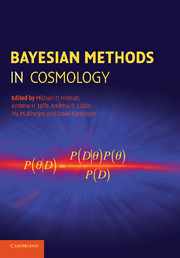Book contents
- Frontmatter
- Contents
- List of contributors
- Preface
- Part I Methods
- Part II Applications
- 7 Bayesian source extraction
- 8 Flux measurement
- 9 Gravitational wave astronomy
- 10 Bayesian analysis of cosmic microwave background data
- 11 Bayesian multilevel modelling of cosmological populations
- 12 A Bayesian approach to galaxy evolution studies
- 13 Photometric redshift estimation: methods and applications
- Index
9 - Gravitational wave astronomy
Published online by Cambridge University Press: 11 April 2011
- Frontmatter
- Contents
- List of contributors
- Preface
- Part I Methods
- Part II Applications
- 7 Bayesian source extraction
- 8 Flux measurement
- 9 Gravitational wave astronomy
- 10 Bayesian analysis of cosmic microwave background data
- 11 Bayesian multilevel modelling of cosmological populations
- 12 A Bayesian approach to galaxy evolution studies
- 13 Photometric redshift estimation: methods and applications
- Index
Summary
A new spectrum
Just a century ago, our view of the cosmos was limited to the single window provided by optical telescopes. In the intervening years, new windows opened as cosmic rays, neutrinos, radio waves, X-rays, microwaves and gamma rays were enlisted in our quest to understand the Universe. These new messengers have revolutionized astronomy and profoundly altered our perception of the cosmos.
Despite these impressive advances, almost everything we know about the Universe beyond our own galaxy comes from observing light of various energies. Hopefully this will soon change as a new spectrum is opened by the direct detection of gravitational waves. Just as our sense of hearing complements our sense of sight, gravitational wave astronomy can extend and enrich the picture provided by electromagnetic astronomy (Hughes 2003).
Astrophysical and cosmological sources of gravitational waves are expected to produce signals that span over twenty decades in frequency, ranging from primordial signals with frequencies as low as 10−18 Hz, to supernovae explosions that reach frequencies of 104 Hz. A suite of detection techniques have been proposed to detect these signals, from acoustic (bar) detectors for narrow band detection of high-frequency waves, through to polarization maps of the cosmic microwave background radiation to look for imprints of the lowest frequency waves. Pulsar timing arrays are a promising technique for detecting waves in the 10−8 Hz range, and there is an outside chance that this technique might yield the first direct detection.
- Type
- Chapter
- Information
- Bayesian Methods in Cosmology , pp. 213 - 228Publisher: Cambridge University PressPrint publication year: 2009
- 1
- Cited by



